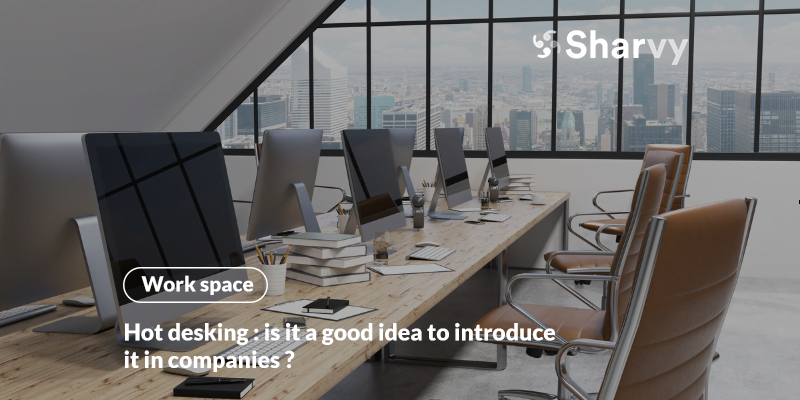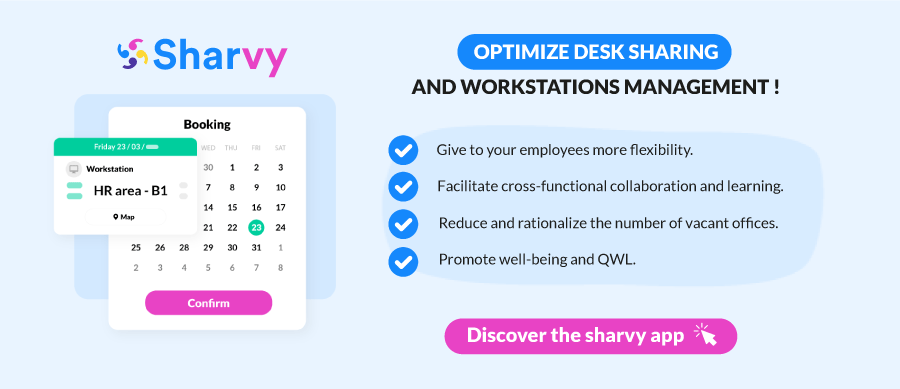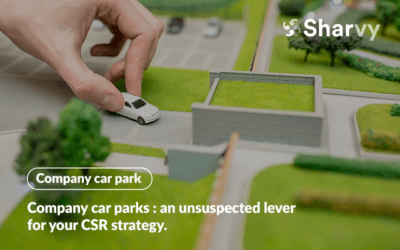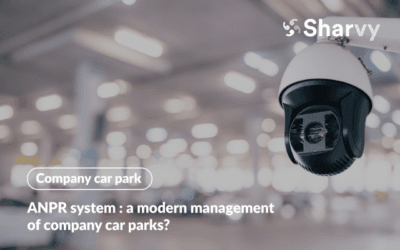Now the train to hybrid work is unstoppable! For many years, the way we work has been changing, but slowly. Then, in 2020, the tipping point came with the Covid-19 crisis. It shook up previously established working methods, forcing the whole world into confinement.
Since then, the work revolution has been launched. The combination of face-to-face and remote working is now the daily reality for 55% of employees, according to the 2022 Barometer of JLL, the leading company in real estate consulting.
However, the generalization of hybrid work is not at the expense of the office. Indeed, the same study reveals that 45% of employees juggle between working in a third place (coworking and corpoworking), working at home, and working in person.
As a result, and not surprisingly, people continue to come to the office, and the office acts as a “rallying point” for all talents, a place of emulation. It is thus the central meeting point of the company, in other words: the heart from which the energy comes. And now, it must combine a renewed organizational culture and community dynamics with greater flexibility in work.
To achieve this, many companies are rethinking their workspaces to build the foundations of hybrid working, where everyone can find their interest. As a result, more and more companies are becoming interested in hot-desking. But is it (really) a good idea? In this article, we look at this trend and decipher it!
What is hot desking? Definition, origins, and how it works.
Until now, we have known the classic open space. However, nowadays, “dynamic” open spaces are regularly found in companies where employees no longer have a dedicated workstation. This can also be called hot desking.
This means that everyone is free to sit wherever they want, depending on their daily tasks and needs.
For the more curious, this anglicism comes from the naval expression “hot bunking“, which designates a common practice among sailors, who, due to the shortage of bunks, are forced to share one with several. Usually, one for every two or three sailors. In many cases, the seafarers slept in shifts. When one seafarer gets up to start his shift, another finishes it and takes the first free bunk to rest. This is before the body heat of the other has dissipated, hence the expression “hot berth”! This solution minimizes the space needed for sleeping and allows the square meters saved to be used for other purposes.
And… as surprising as it is, hot bunking is inspiring more and more companies to apply this organization within their premises.
How does it work? Child’s play! Each workstation has the necessary office equipment (computers and office supplies) in a hot-desking organization. This is done with modular and scalable furniture so everyone can adapt their workstation to their needs. So, once on site, time is well-spent! Next, employees choose their anchor point for the day and begin their tasks.
Initially implemented by companies whose sector requires a rotation of employees to ensure the continuity of the activity, 24h/24 and 7d/7, it now appeals to all companies wishing to modernize and provide their employees with more flexibility.
Why is hot desking on the rise in recent years?
In an age of shared goods – whether cars, accommodation, or services – hot desking is becoming increasingly popular in companies. There are many reasons for this. Here are some of them.
1. Hot desking offers a significant economic advantage to companies!
Traditionally, about 75% of the space was allocated to individual workstations and 25% to meeting rooms. Today, the trend is reversing with the increase in real estate costs and the growing number of vacant offices in companies (due to teleworking, business travel, etc.).
The “classic” work organization in which each employee has the same workspace all year round is becoming obsolete. This is why companies are now wondering how to optimize their workspaces, no longer in terms of people but in terms of use.
This is why the demand for “hot desking” “desk sharing” and “flex office” arrangements has been exploding recently! Thanks to these arrangements, companies can reduce a considerable proportion of their operating costs while saving up to 40%, depending on the variation in the hot-desking rate (between 10% and 50% less office space, for example). A significant saving these days.
2. An asset to accelerate innovation, creativity, and skill sharing
It should be remembered that hot desking goes hand in hand with a flexible work organization, combining teleworking and face-to-face work. In correlation, this organization leads to less unnecessary travel, greater efficiency, and psychological comfort for employees. This is the first point to consider, as it makes them more motivated and happier.
At the same time, the configuration of the workspaces encourages the decompartmentalisation of teams, which favors collective intelligence, collaboration, and creativity. In this dynamic, sharing skills between employees with different jobs, strengths, and experience is easier, which stimulates innovation and leads to more creative and ambitious projects.
3. Hot desking is a way for companies to stay competitive!
By opting for hot desking, companies put work flexibility, well-being, and QWL. And they are not wrong! A survey conducted in 2022 by OpinionWay revealed that 38% of employees are ready to resign if their employer gives up on work flexibility (teleworking, flexible hours, choice of workspace, etc.).
As a result, and during the war for talent, if companies wish to avoid the impact of the “big resignation,” they must remain competitive in terms of flexibility to meet the crying expectations of their employees and retain them. Hot desking can be one of the solutions to this.
Want to know more about hot desking, desk sharing, and flex office? Check out our case studies and discover how a leader in the food industry digitized its new head office with Sharvy!
However, is hot desking suitable for all companies?
Although hot desking has many advantages, this work organization is suitable for only some companies.
For example, many employees deal with sensitive and confidential data daily. Therefore, when hot desking is announced, these employees may be more reluctant, mainly because they will have to clean up their desks to prevent any data leakage. In other words, they will have to put away their documents and personal belongings in named lockers each evening to leave a clean and welcoming office for the person who will occupy it the next day. In addition, employees in this type of position generally prefer to work in a more private workspace, away from prying eyes.
Similarly, many teams need a consistent structure and continuous collaboration throughout the working day. These may need help with constantly changing seating arrangements. In addition, each employee must find support and recognition from their peers to nurture a sense of belonging, which can gradually fade away without good hot-desking management. This is a second point to consider, which can slow down the implementation of hot desking.
Consequently, if you find yourself in the above explanations, the acclimatization period to this new work organization may be longer and/or less adapted to your needs.
Mix hot desking with desk booking to excel in your work organization!
Let’s remember that! After all, hot-desking works on a “first come, first served” basis.
At first glance, the fair distribution of workstations would take care of itself between adults. But unfortunately, this is not the case. As a result, early risers will be spoilt for choice in this work organization, with little risk of competition from colleagues for a seat. After 9 am, however, seats are likely to be scarce. Thus, employees will have no choice but to take the remaining option.
To overcome these uncertainties and to avoid this new organization having the opposite effect and creating tensions, an office booking tool can be your best support to ensure the success of your flexible working model.
Thanks to a dedicated web & mobile application, your employees can reserve a workstation before they arrive on-site. This is what we call : desk booking. At the same time, they can check availability over the next few days. This allows them to organize their week more easily according to their wishes and/or personal constraints. If necessary, changes or cancellations can then be made in a matter of seconds.
Therefore, desk booking is not intrinsically linked to a hot-desking model, but the two work well together! Think of desk booking as a way to improve your employees’ daily life, preventing every morning from being a frantic race for the best seat and facilitating the implementation of a flexible work organization, such as hot desking.
What are the tips for designing an adequate hot-desking space?
The most important thing is to provide modular and scalable furniture so that employees can adapt their workstations to their needs.
- Desks : Ideally, they should be height-adjustable and motorized to make them easily changeable and more suitable for a flexible working environment.
- Chairs : A good office chair is essential! The backrest and seat should be ergonomically correct and adjustable to a significant level to meet health and safety legislation. It should be noted that every company employs people of all sizes and shapes. So, as well as combating the effects of sedentary office work, you must consider individual characteristics and pre-existing health problems.
- Ergonomic tools : Mice, keyboards, and mouse pads should be provided for all employees, even if they have brought laptops from home. You can also give them a padded wrist rest to prevent muscle soreness and repetitive strain injuries.
- Storage : In a “hot desking” environment, it is essential to provide named lockers so that each employee can, at the end of the day, put away their files and leave the office clean and welcoming for the colleague who is going to use it the next day.
- Connectivity : 80% of companies believe connectivity and ergonomic issues at workstations are challenging to successful hot-desking (Kensington Study, 2018). For this reason, it makes sense to provide each employee with laptops of the same brand to limit connectivity issues (USB port, charging, etc).
To help you, download our free checklist!
In conclusion
There is no doubt that hot desking is becoming increasingly popular with employers who want to reduce costs and optimize their workspace. The same is true for the younger generation, who are looking for more flexibility and are happy to opt for flexible working spaces.
However, hot desking only fits some companies’ or personalities’ needs and cultures. Some employees will not be convinced by this revolutionary solution and will find it more challenging to play the hot-desking game. Sometimes, a period of acclimatization is enough to adopt this practice and benefit from its many advantages. Sometimes, it is necessary to realize that this practice is not adapted to the needs.
So, when asked whether it makes sense to implement hot desking in the workplace, the answer may be disappointing. The answer may disappoint you, but we would say that “it depends.” Several factors come into play (the level of flexibility, employees’ commitment to this new practice, the management of hot desking, the implementation of tools such as desk booking, etc.).
It is up to you to carefully study your company’s needs (economic and human), the tools to be implemented, and above all, the internal demands. Then, get your employees to participate in the transformation actively. Your employees are the first to experience change daily. Trust them. If they are on the front line of change, they will undoubtedly have excellent ideas for making your transformation plan a success!
Have a question? Check out the FAQ!
The announcement of hot desking: how to counter employees' resistance to change?
Understandably, your teams may fear the change : it is destabilizing, stressful, and time-consuming. However, that is why change must be accompanied!
Remember that transitioning from a “classic” work organization to a “hot desking” type of organization should not be imposed on your employees overnight. To make the transition a success, remember to ask for regular feedback. In this way, you show that the change is not imposed on them and that they are the actors.
At the same time, set up an acculturation process. This helps to reduce many aspects of resistance to change. You can, for example, distribute learning content and organize workshops or training courses to explain why this change is necessary, how it will take place, and what the personal interest is in playing the hot desking game.
Is there a (real) difference between hot desking and desk sharing?
Hot desking and desk sharing are two types of work organizations in which employees need a dedicated office. Thus, when they arrive on-site, they choose their anchor point for the day according to their needs and the tasks they have to perform.
Therefore, the difference between these two anglicisms is minimal. However, it can be noted that hot desking is particularly suitable for companies where employees work different hours (days/nights, shifts, etc.). In other words, it is a work organization better suited to mobile, nomadic employees and those working in teams (e.g., telephone advisers). Desk sharing is, therefore, suitable for a more significant number of companies.
At the same time, and in practice, hot desking only works with impromptu reservations (in other words, without prior planning). Today, this is still the case in some companies, but many have decided to combine hot desking with the implementation of a desk booking tool. This is why the definition of hot desking now overlaps with desk sharing.
Finally, there is one last difference. Desk sharing is usually implemented on all the company workstations, which is rare for hot desking. Most of the time, several areas in the company are dedicated to it, but not all workstations are involved.
How does hot desking improve productivity and well-being at work in new office spaces?
Hot desking, by redefining traditional work modes, encourages a more collaborative work culture. By allowing employees to choose where and how they wish to work within the company, it not only enhances their quality of work life but also boosts their productivity. Shared workspaces, such as coworking spaces and meeting rooms, are optimized to cater to various needs and activities, making the environment more flexible and comfortable.
This approach also provides an adaptable personal workspace, where shared desks and collaborative work areas are designed to promote interaction and the exchange of ideas, crucial for startups and companies looking to innovate. By incorporating carefully designed collaborative spaces, companies can create a workplace that not only meets the demands of modern professional life but also enhances the well-being of its occupants.
Therefore, we can conclude that hot desking not only meets the demand for flexible spaces but also helps create work environments that better align with employees’ expectations, thereby strengthening their engagement and job satisfaction.
Want to learn more? Check out our latest articles!
Flex desk & teleworking : how do you combine these two models?
What is the flex desk in the workplace? Why combine it with a teleworking policy? How do you go about it? What advice do you have?
Company car parks : an unsuspected lever for your CSR strategy.
How can your company car park support your CSR strategy in environmental, economic and social terms? Here’s our advice!
ANPR system : a modern management of company car parks?
What is the ANPR system? What are the benefits for your company car park? What are its challenges and limitations? Focus.
Subscribe to our newsletter!
Resources
Contact us
+44 117 463 6990







